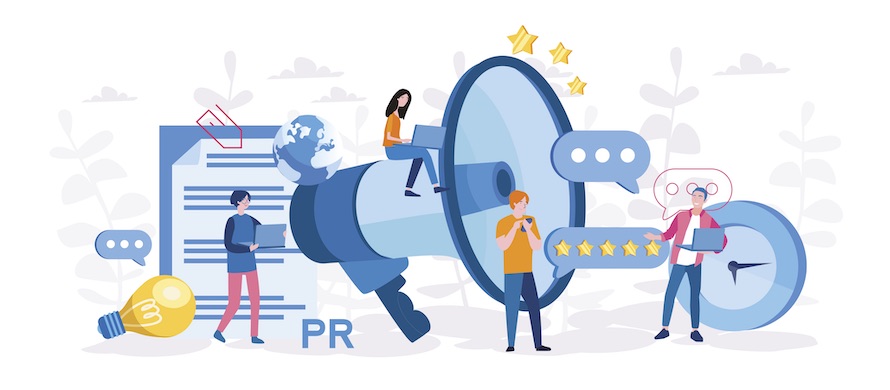Business is complicated.
Communications shouldn’t be.
The right message for each target audience, delivered via the right channel at the right time, is what gets the job done.
This is where digital PR comes in.
What is Digital PR?
Digital PR is the process of managing public relations for a company through the use of digital channels such as websites, mobile apps, email newsletters, etc. The goal of digital PR is to increase awareness for your company about a product or service among consumers.
Why is everyone talking about Digital PR?
Digital PR is one of the fastest growing areas of public relations. Digital PR is a way for businesses to connect with customers through various channels like social media, search engines, etc. This allows them to reach out to potential clients and build relationships with them, something that was previously difficult to do with traditional PR. Digital PR makes it easier to increase awareness of your business, generate leads, and ultimately convert those leads into sales.
How Digital PR helps your brand to break through the noise
Brands face greater competition than ever before. It isn’t important to just get attention. It has to be relevant!
Zen’s PR team knows exactly how to deliver, so if you are looking for a PR agency that delivers proven business results, look no further.
While many digital PR firms make bold claims, we walk the talk. We are the only agency to be honored by both the White House and the United Nations as a Top 100 Company in the United States.
A PR strategy is a crucial piece of a holistic marketing program. When planned and executed effectively, digital PR can be a highly effective lead generation, credibility and awareness tool for organizations.
Buyers today are information-savvy and research-oriented when evaluating and making business decisions for their organizations.
That means organizations have to reach prospects on many different channels that influence buying decisions, including business and pr trade publications, social media and review sites, and other third-party sources such as blogs or product forums.
This requires a strategic, multi-pronged approach to public relations.
7 Basic Tenets of a Digital PR Strategy
Companies need to create a solid foundation for B2B PR success. Blindly pitching reporters and commenting on breaking news stories with no good plan or strategy is risky and restricts results. Rather, focus on establishing these essential components of a digital PR strategy:
1. Accurate Buyer Personas:
B2B purchases are much more involved than most consumer purchases. They frequently require bigger budgets and complex technology or solutions. Buyer personas allow organizations to better understand their target audiences and develop a digital PR program that appeals to their own needs, pain points, and pursuits.
2. Precise Messaging:
Tailor your messaging and highlight the most compelling product or service advantages and differentiators for each target market. Consider your buyer personas and also the particular challenges faced by each audience to create content and digital PR campaigns that have maximum impact. Are your key messages as crisp as possible? Do they adequately differentiate you?
We dig deep to discover the words, tone, and image that best resonate with who you are and connect it to what gets you the most share of voice. The end result? Your brand story is one people love to share—and it leads to more opportunities for you.
3. Competitive Landscape Analysis:
Take the time to truly understand the strengths and weaknesses of your competitors and the greater landscape. Assess their media, target audiences and digital marketing campaigns to better guide your digital PR strategy. In many cases, their success can be reverse engineered to benefit you!
4. Compelling Thought Leadership:
Your team is your most valuable asset. Your leadership, your sales team, and even your most technical folks are often well versed in market trends, understand pain points and company differentiators. These in-house experts can provide great fodder for media pitches, interviews and content such as blog posts and infographics. They don’t have to be awesome communicators. They provide the steak. We provide the sizzle.
5. Turn Data into Dollars:
A strong and steady flow of newsworthy company announcements is great, but most companies have to create their own news to secure earned media and spur coverage on a consistent basis. A great way to do this is through your own data and studies. Data and stats from reputable sources such as CB Insights or Forrester or Gartner add credibility to media pitches and news stories. We can go even further by leveraging internal sources or conduct and create original research reports which generate media coverage and leads.
6. Amplify your Digital PR:
We ensure that you are able to maximize every piece of coverage. How? By promoting across social media, via landing pages, email, mobile apps and at events/trade-shows.
7. Track Results:
What gets measured gets managed. We measure both quantitatively and qualitatively to see what’s working and where to double down and get the most bang for your buck.
What can B2B Digital PR do for you?
- Increase visibility.
- Create brand awareness.
- Increase demand generation.
- Improve stakeholder relations.
- Go from corporate messaging to compelling storytelling.
- Reenergize subsidiaries.
- Drive sales.
- Establish thought leadership.
Digital PR Agency Services We Offer:
- B2B Marketing and PR around New Product and Service Launches.
- Creating Compelling Content and Original Studies.
- Newsjacking (Where we tie your company into what’s current and trending).
- Media and Press Training
- Press Kit Creation – Digital and Physical
- Analysis and Recommendations on Current Digital PR Strategy
- B2B Influencer Marketing








